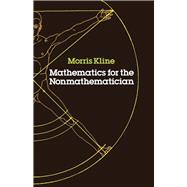
Note: Supplemental materials are not guaranteed with Rental or Used book purchases.
Purchase Benefits
Looking to rent a book? Rent Mathematics for the Nonmathematician [ISBN: 9780486248233] for the semester, quarter, and short term or search our site for other textbooks by Kline, Morris. Renting a textbook can save you up to 90% from the cost of buying.
Morris Kline: Mathematics for the Masses
Morris Kline (1908–1992) had a strong and forceful personality which he brought both to his position as Professor at New York University from 1952 until his retirement in 1975, and to his role as the driving force behind Dover's mathematics reprint program for even longer, from the 1950s until just a few years before his death. Professor Kline was the main reviewer of books in mathematics during those years, filling many file drawers with incisive, perceptive, and always handwritten comments and recommendations, pro or con. It was inevitable that he would imbue the Dover math program ― which he did so much to launch ― with his personal point of view that what mattered most was the quality of the books that were selected for reprinting and the point of view that stressed the importance of applications and the usefulness of mathematics. He urged that books should concentrate on demonstrating how mathematics could be used to solve problems in the real world, not solely for the creation of intellectual structures of theoretical interest to mathematicians only.
Morris Kline was the author or editor of more than a dozen books, including Mathematics in Western Culture (Oxford, 1953), Mathematics: The Loss of Certainty (Oxford, 1980), and Mathematics and the Search for Knowledge (Oxford, 1985). His Calculus, An Intuitive and Physical Approach, first published in 1967 and reprinted by Dover in 1998, remains a widely used text, especially by readers interested in taking on the sometimes daunting task of studying the subject on their own. His 1985 Dover book, Mathematics for the Nonmathematician could reasonably be regarded as the ultimate math for liberal arts text and may have reached more readers over its long life than any other similarly directed text.
In the Author's Own Words:
"Mathematics is the key to understanding and mastering our physical, social and biological worlds."
"Logic is the art of going wrong with confidence."
"Statistics: the mathematical theory of ignorance."
"A proof tells us where to concentrate our doubts." ― Morris Kline
The New copy of this book will include any supplemental materials advertised. Please check the title of the book to determine if it should include any access cards, study guides, lab manuals, CDs, etc.
The Used, Rental and eBook copies of this book are not guaranteed to include any supplemental materials. Typically, only the book itself is included. This is true even if the title states it includes any access cards, study guides, lab manuals, CDs, etc.